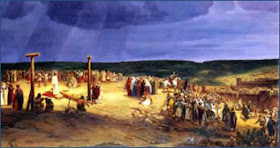Since my last post was about a cemetery tour, let's continue the theme.
Forest Lawn's founder, Hubert Eaton, pioneered the "before need" concept of burials. After learning the trade in St. Louis, he moved out to California to work at a cemetery in Tropico--now Glendale. When he took over a few years later he renamed the place Forest Lawn, and his vision was to make it the Happiest Burial Ground on Earth.
BTW, the pictures of Forest Lawn's David reproduction & of Walt Disney's garden and crypt come fromWikipedia and were taken by Kafziel. I like that name.
Eaton wanted his place to be upbeat, rather than dismal. He brought in ducks and birds and fountains, then commenced buying trips to Europe to outfit his cemetery. Big, beautiful, pretty, and inspiring were his criteria, and he put in three churches with thematic stained glass windows. He filled the churches and buildings with art, rich tapestries, antiques, more stained glass--you get the picture. And this was all back in the 1930s.
This information comes from a book I picked up at the library: Encyclopedia of Bad Taste by Jane and Michael Stern. I'm not vetting it--it's way too hot--but just passing it along.
As you can imagine, Hubert Eaton's proclivity for showmanship and happiness did not comport with the state Board of Embalmers and Funeral Directors back then, and they tried (unsuccessfully) to deny him a mortuary license. The film industry loooooved Forest lawn.
Ronald Reagan and Jane Wyman and at least 60,000 other couples were married there.
So many stars are buried at Forest Lawn! Silent film icons like Jean Harlow, Clara Bow, and Buster Keaton, personalities like Liberace, innovators like Walt Disney (that's his crypt and garden at right), and today's deceased celebs, including Michael Jackson.
Wikipedia has a list--and there are books about the place too.
Later, Eaton built the Hall of the Crucifixion to house the World's Largest Framed Canvas Painting--45 feet high by 195 feet long. Wonder if Eaton was related to P.T. Barnum?
That painting--the middle third of which you see at right--was brought to American at great expense by the artist, Jan Styka, in the early 1900s. Styka painted "The Crucifixion"--which he called "Golgotha"--at the suggestion Paderewski, the famous pianist, and had exhibited it in Warsaw. He hoped to see it displayed at the St. Louis Exposition, but no one could find a place for it.
The artist had to leave it in America when he returned to Poland, because he just ran out of money. He never saw it again--and that's from the Forest Lawn website. Wikipedia says "The Crucifixion" sat in the basement of the Chicago Civic Opera Company for 40 years, until Eaton purchased it in 1944. And built the hall to display it in.

.jpg)


No comments:
Post a Comment